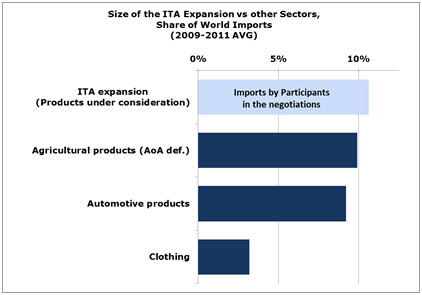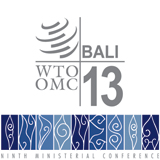9TH WTO MINISTERIAL CONFERENCE, BALI, 2013
Briefing note: Information Technology Agreement (ITA) and product expansion negotiations
Updated: November 2013
THIS EXPLANATION is designed to help the public understand developments in the WTO. While every effort has been made to ensure the contents are accurate, it does not prejudice member governments’ positions.
> Ministerial Conferences
> Bali Ministerial Conference
> Other briefing notes
What is the ITA?
The Information Technology Agreement (ITA) was the first tariff liberalization agreement negotiated in the WTO after its establishment in 1995. The ITA is also the most significant. It led to the elimination of import duties on products which in 2012 accounted for an estimated US$ 1.6 trillion, almost three times as much as when it was signed in 1996. The IT sector has been one of the fastest growing sectors in world trade. Today, trade in these products accounts for approximately 9.5 per cent of global merchandise exports.
The ITA covers a large number of high technology products, including computers, telecommunication equipment, semiconductors, semiconductor manufacturing and testing equipment, software, scientific instruments, and their parts and accessories.
The ITA was agreed on 13 December 1996 through a “Ministerial Declaration on Trade in Information Technology Products”, which was announced at the first WTO Ministerial Conference, held in Singapore. Signed initially by 29 members, participation quickly increased at the beginning of 1997 when a number of other members decided to join the Agreement. It had a total of 42 participants by the time it was implemented in mid-1997. Participation in this plurilateral agreement has consistently increased since then.
Following Russia's decision to join, the ITA now accounts for 78 participants.
The ITA requires each participant to “bind” (i.e. set a maximum import duty that can be imposed) and eliminate customs duties for all products specified in the Agreement. Because the ITA concessions are included in the participants' WTO schedules of tariff concessions, the tariff elimination is implemented on a most-favoured nation (MFN) basis. This means that even countries that have not joined the ITA have benefited indirectly from the trade opportunities generated not only by its tariff elimination, but also by the large economies of scale of global production networks that have been developed over the years. These have, in turn, led to more affordable, high-quality products and the establishment of new IT-enabled industries and services. In practical terms, the ITA has significantly contributed to reducing the prices of IT products for both consumers and importers, and has lowered costs for inputs for exporters of highly sophisticated technological products.
Today, 78 ITA participants account for approximately 97 per cent of world trade in information technology products. Approximately 90 per cent of world trade in these products is imported duty-free.
Because products covered by the ITA — including intermediate products — can be freely moved across borders without paying import duties, the IT industry has had the opportunity to specialize and to profit from large economies of scale. This is one of the reasons why global production networks and supply chains have proliferated in the sector, leading to improved productivity and efficiency in the industry. It has also allowed certain developing country participants to attract investment in the sector, thereby assisting in the development and economic growth of countries such as Malaysia and Costa Rica.
What is the ITA product expansion?
In May 2012, on the occasion of the 15th anniversary of the ITA, it was recognized that whole new categories of IT products had been developed, including a number of products which do not fall within the scope of the existing ITA. In the light of new technological developments, some WTO members considered that the current product coverage of the ITA should be expanded.
In June 2012, six ITA participants (United States, European Union, Japan, the Republic of Korea, Chinese Taipei and Costa Rica) initiated an informal process towards launching negotiations for the expansion of the product coverage of the ITA. This process led to the establishment of a technical working group which has been meeting informally in Geneva, outside of the formal framework of the WTO ITA Committee.
The technical working group started its 15th round of negotiations on 11 November 2013, and continued these negotiations into the week of 18 November, with a view to agreeing on a list of products for which trade should be liberalized. However, the parties were not able to narrow their differences for an agreement, and the negotiations were suspended.
How many WTO members are participating in the ITA product expansion negotiations?
The technical working group currently consists of 27 ITA participants (counting the European Union as one), including: Albania; Australia; Canada; China; Colombia; Costa Rica; Dominican Republic; El Salvador; the European Union; Guatemala; Hong Kong, China; Iceland; Israel; Japan; Korea; Malaysia; Mauritius; Montenegro; New Zealand; Norway; the Philippines; Chinese Taipei; Singapore; Switzerland; Thailand; Turkey; and the United States.
Counting the 28 EU member states individually, there are 54 WTO members participating in the ITA product expansion negotiations. Together, these members account for approximately 90 per cent of world trade in the products being proposed for inclusion in the product expansion negotiations.
What is the current level of MFN tariffs for the products under consideration in the ITA product expansion?
Although the average applied MFN tariffs maintained by the 54 WTO members participating in the ITA expansion negotiations range from 0 per cent to 7.1 per cent for the products being negotiated, the import duties for certain products in key markets are as high as 35 per cent. Given the high volume of trade in these products, tariff elimination would translate into massive savings for the IT industry. According to some estimates, the gains from eliminating these tariffs could be as high as US$ 15 billion per year.
Beyond the monetary gains resulting from the elimination of import duties, traders would also gain from significant improvements in terms of market access predictability and certainty. This is because a number of these products are still currently unbound (i.e. they do not have a legal commitment in terms of the maximum import duty that can be applied) or have high bound levels (which allows the country to increase the applied import duty at any time in the future). With the ITA product expansion, the 54 WTO members would have the legal obligation not to impose duties on those products.
What would be the impact of the ITA product expansion?
The impact of eliminating customs duties on the products under negotiation could be substantial. However, the exact number would obviously depend on the specific products that participants agree to include in the final expansion agreement. According to some estimates, participants were considering a liberalization package that would account for roughly US$ 0.8 trillion to US$ 1.4 trillion of annual trade. WTO members participating in these negotiations account for approximately 90 per cent of such trade.

